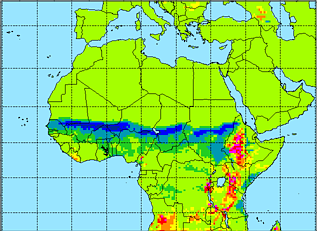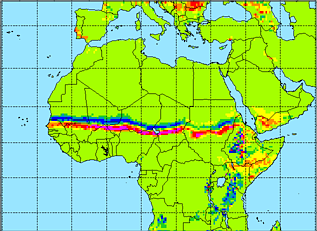|
Volker Ermert1, Andreas H. Fink1, Andy P. Morse2, and Anne E. Jones2
1 Institute for Geophysics and Meteorology, University of Cologne
2 Department of Geography, University of Liverpool
Malaria is one of the most serious health problems in the world. The projected climate change
will alter the range and transmission potential of malaria in Africa. In this study, potential
changes in the malaria transmission will be assessed by forcing a malaria model with data from
ensemble scenario runs of a state-of-the-art regional climate model.
The Liverpool Malaria Model
(LMM, Hoshen and Morse 2004) from the Geography Department of
the University of Liverpool as well as the MARA Seasonality Model
(MSM, Tanser et al. 2003) are utilized. LMM simulates the spread
of malaria at a daily resolution using daily mean temperature and 10-day accumulated precipitation.
Various sensitivity experiments revealed that the LMM is
fairly sensitive to the setting of the model. For example the simulated malaria prevalence (i.e.
the proportion of the population that is carrier of the malaria parasite) strongly depends on the
mosquito survival scheme. The MSM is accounting for the seasonality of malaria and
is based on temperature and precipitation criteria that decide on the monthly
malaria suitability.
The present-day ensemble runs were performed by the LMM on a 0.5° grid for 1960-2000. The LMM
was driven by data from the REgional climate MOdel
(REMO), with a land use and cover according to
the Food and Agriculture
Organization (FAO).
The malaria projections were carried out for 2001-2050
according to the climate scenarios A1B and B1 as well as FAO land use and cover changes.
For the present climate (1960-2000), LMM simulations show a decrease in the malaria prevalence from
the Guinea Coast towards the Sahel. The regions of epidemic malaria occurrence, as defined by a large
interannual variability of the annual malaria prevalence maximum, lie just north of about 15°N.
Farther south, the malaria occurs throughout the year and is therefore endemic.
Largely due to the land surface degradation, REMO simulates a prominent surface heating and a
significant reduction in annual rainfall amount over most of tropical Africa in either scenario. As
a consequence, the malaria projections show a decreased spread of the malaria disease in most parts
of West Africa for the decade 2041-2050. The variability of malaria prevalence, however, is increasing
in the southern part of the Sahelian zone (between 13 and 16°N). As a result, epidemics in these
more densely populated areas are becoming more likely as the population lose parts of their immunity
against malaria. The level of the malaria transmission farther south remains stable. However,
the MSM simulates shorter transmission seasons depending on a dryer rainy season.
Due to higher temperatures and nearly unchanged precipitation amounts the malaria prevalence
and the duration of the transmission season are increasing in East Africa,
in particular in highland areas.
Areas where malaria transmission is becoming more stable or instable are side by side.
Highland areas that were formerly unsuitable for malaria are becoming suitable in the projected warmer
future climate and epidemics are becoming more frequent. In some other regions transmission is increased and people
will improve their partial immunity against malaria.
|
| a) |

|
b) |

|
Fig.: (a) Differences in the annual averaged malaria prevalence and (b) in the standard deviation
of the annual malaria prevalence maximum between 2041 to 2050 of the A1B scenario and the period 1960 to 2000..
|
